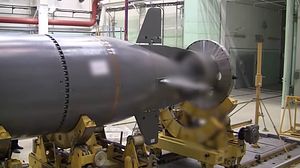The Russian Navy is expected to deploy over 30 ‘Poseidon’ nuclear-capable unmanned underwater vehicles (UUVs), a source told TASS news agency on January 12. Two Poseidon-carrying submarines are slated to enter service with the Russian Northern Fleet while the other two will join Russia’s Pacific Fleet. Each submarine will be capable of carrying up to eight UUVs. Consequently, a total of 32 Poseidon UUVs could enter service with the Russian Navy in the coming years.
“Two Poseidon-carrying submarines are expected to enter service with the Northern Fleet and the other two will join the Pacific Fleet,” the source told TASS news agency on January 12. “Each of the submarines will carry a maximum of eight drones and, therefore, the total number of Poseidons on combat duty may reach 32 vehicles.”
The Russian Ministry of Defense (MoD) has neither publicly commented nor confirmed the exact number of Poseidon UUVs to be inducted into service.
The new UUV will likely be carried by Project 09852 submarines – based on the 949A Oscar II-class nuclear-powered guided missile submarine —or Project 09851 subs — reportedly a downsized variant of the Borei-class of nuclear-powered ballistic missile submarines — two of which were laid down in December 2012 and July 2014 respectively at the Sevmash shipyard. The defense industry source confirmed this month that Project 949A Oscar II -class boats may be armed with the Poseidon UUV after “after their appropriate upgrade.”
Notably, while the source cites the total number of UUVs to be carried by each of the upgraded submarines at eight, past Russian sources noted that the Project 09852 boats will only be capable of carrying up to six UUVs, while Project 09851 submarines would accommodate up to four Poseidon UUVs. Given the purported size of the Poseidon UUV — twice the size of a submarine-launched ballistic missile — the latter number appears to be somewhat more realistic.
Russia purportedly commenced sea trials of the Poseidon in December 2018. The ongoing tests are part of experimental design work rather than full-fledged sea trials, according to a Russian defense industry source. As I reportedly previously, Russia’s MoD already announced in July that sea trials, primarily focused on the UUV’s guidance system and underwater operations in autonomous mode, were under way. The underwater tests are likely carried out by a B-90 Sarov-class Project 20120 diesel-electric submarine, which serves as the launch platform for the UUV.
As I wrote previously, I continue to harbor doubts about the Poseidon program overall:
The UUV is being designed a weapon of last resort to strengthen Russia’s nuclear deterrence posture vis-à-vis the United States and NATO. Torpedoes equipped with a nuclear propulsion system and fitted with a nuclear warhead for use over long distances were first conceived in the Soviet Union back in the 1950s but were considered impractical and unreliable at the time.
There are still questions whether Russia will be capable of building a reliable miniaturized nuclear reactor for the UUV [next to other technical challenges].
The drone is listed in Russia’s state armament program for 2018-2027 and is expected to be delivered to the Russian military in the late 2020s. However, the ‘Poseidon’ UUV will likely not move beyond the prototype stage as it appears to have been designed primarily for negotiation purposes for future strategic arms reduction talks with the United States and NATO.
It is also remains unclear whether the Poseidon UUV, if operationalized, will only serve as a nuclear-warhead delivery platform or could be used for other purposes including intelligence, surveillance, and reconnaissance (ISR) missions.

































